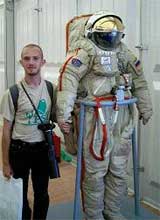 Historically and currently, Russia has always been at the forefront of space exploration. The best space suits are manufactured in Russia at the Zvezda production facility. The latest achievement, the Orlan-MK suit, represents a near-revolution in design. This suit boasts several outstanding features.
Historically and currently, Russia has always been at the forefront of space exploration. The best space suits are manufactured in Russia at the Zvezda production facility. The latest achievement, the Orlan-MK suit, represents a near-revolution in design. This suit boasts several outstanding features.
Currently, only Russia and the United States possess the technology to manufacture suits for extravehicular activities (EVA). Although the objectives for the space suits in both countries are similar, the approaches differ significantly.
This explains why, for over two years, crew members aboard the International Space Station (ISS) have continued to use the Orlan suits. The issue with the American suits is that they are designed for only six months of operation. American designers based their calculations on the premise that if the crew stays in space for an extended period, the suits would periodically be returned to Earth for maintenance. However, due to issues with the American space shuttles, all astronauts had to switch to the Russian suits.
The Orlan suit is designed for effective use in orbit for up to four years. The only maintenance required involves replacing the oxygen tanks, absorption canisters, and replenishing water reserves. Additionally, adapting the Russian suit to fit any body size is simpler compared to the American counterpart. A significant advantage of the Orlan suit is that it fits any astronaut comfortably without constriction. Astronauts can don the suit independently without assistance. To do so, they simply step through the hatch located at the rear of the suit, which also serves as a backpack housing life-supporting equipment.
In contrast, the American suit consists of two parts connected at the waist, requiring two people to put it on—similar to how knights donned armor in medieval times—making the process more time-consuming. American experts have decided to emulate the Russian design by incorporating a hatch system into their suits for interplanetary flights, following the same principles as the Russian models.
The Orlan-MK is the fifth version of the Orlan series. Its primary distinction from the Orlan-M, currently in use aboard the ISS, is its onboard computer. The new Orlan suit is the first Russian suit equipped with a computer, enhancing its autonomy and functionality. This feature becomes apparent as soon as the suit is worn. The suit indicates which systems need to be monitored and in what sequence before stepping into space, and once the astronaut has exited the station, it continuously reports the status of all systems within the suit. In case of non-standard situations (e.g., a drop in suit pressure, increased oxygen consumption), the computer immediately alerts the astronaut (displaying information on a screen and emitting an auditory signal) and advises on necessary actions. The computer is positioned on the right side of the chest, allowing the display to remain in the astronaut’s line of sight.
Another innovative detail from Russian engineers is the jet system designed to rescue astronauts in case they become detached from the spacecraft. This system features a frame with 16 small gas engines, an automatic stabilization system, and a control panel. Generally, this system is not used; it can be compared to a parachute system in aircraft, which a pilot may never need to use in their lifetime. However, it is available for emergency rescues. The rescue system, like the suit itself, outperforms similar American designs. In critical situations, an astronaut’s survival depends on their ability to orient themselves and utilize the emergency system quickly.
The first rescue systems are expected to be launched into orbit once regular flights of the American space shuttles resume. Currently, all cargo deliveries to the ISS are managed by Russia, making every kilogram highly valuable. The Orlan-MK is slated for use on the ISS in 2007, coinciding with the expiration of the Orlan-M suits currently in operation.


















































